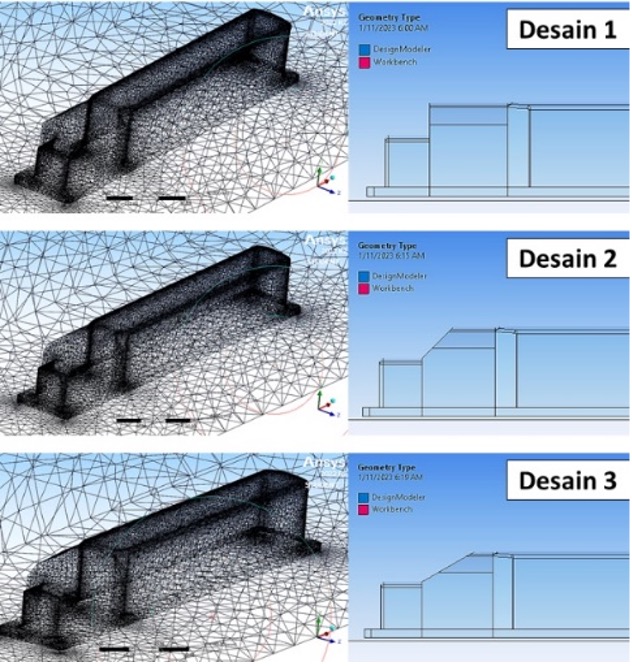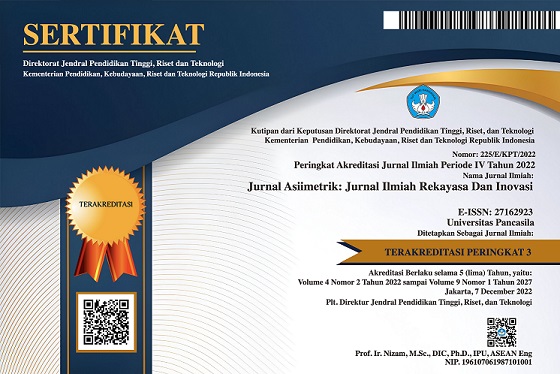Analisis Modifikasi Desain pada Lokomotif CC-201 Tipe GE U18C dengan Metode Simulasi CFD
Design Modification Analysis on the CC-201 Locomotive Type GE U18C using the CFD Simulation Method
Abstract views: 606 | pdf downloads: 541
Abstract
The CC-201-type U18C locomotives are widely used for public transportation in Indonesia. Like other modes of transportation or vehicles, the body's design is an important factor to consider because it influences the aerodynamic capabilities of the vehicle. The study aims to analyze the effect of variations in the design angle of the CC-201 type U18C locomotive body on the coefficient of drag and aerodynamics. The method used in this research is CFD simulation using CAE-based engineering software, Ansys Fluent R2 2022. CFD simulations were performed on locomotive body designs with angle variations of 90°, 135°, and 150° using the same boundary condition parameters. The results show that the locomotive body design with the 60° variation has the smallest drag coefficient value of 0.51076379. The study conclusion explains that changing the angle of 150 degrees at the top of the GE U18C-type locomotive body has a significant effect on lowering the value of the drag coefficient by up to 29%.
Downloads
References
ANSYS (2022) Ansys Fluent: A History of Innovations in CFD. Available at: https://www.ansys.com/blog/ansys-fluent-history-of-innovations (Diakses: 28 Desember 2022).
ANSYS (2023a) ANSYS Meshing User’s Guide. Available at: https://www.ansys.com/search#q=meshing&t=AllAnsysTab&sort=relevancy&numberOfResults=12 (Diakses: 17 Januari 2023).
ANSYS (2023b) Ansys Student - Free Software Download. Available at: https://www.ansys.com/academic/students/ansys-student (Diakses: 7 Januari 2023).
Bahman, A.S. dan Iannuzzo, F. (2018) ‘8 - Computer-aided engineering simulations’, in K. Suganuma (ed.) Wide Bandgap Power Semiconductor Packaging. Woodhead Publishing (Woodhead Publishing Series in Electronic and Optical Materials), hal. 199–223.
Banga, S. dan Zunaid, Md. (2015) ‘CFD Simulation of Flow around External Vehicle: Ahmed Body’, IOSR Journal of Mechanical and Civil Engineering, 12(04), hal. 87–94.
Dechaumphai, P. dan Sucharitpwatskul, S. (2018) Finite Element Analysis with ANSYS Workbench. United Kingdom: Alpha Science International, Limited [Cetak].
Gamayel, A. dan Octavianus, G. (2022) Tutorial Ansys Workbench Untuk Bidang Mekanikal: Jilid 2. Bandung: CV. Media Sains Indonesia [Cetak].
García, J. dkk. (2015) ‘Numerical study of the influence of synthetic turbulent inflow conditions on the aerodynamics of a train’, Journal of Fluids and Structures, 56, hal. 134–151.
Goswami, B. dkk. (2019) ‘Optimization Design for Aerodynamic Elements of Indian Locomotive of Passenger Train’, in A. Prasad, S.S. Gupta, and R.K. Tyagi (eds) Advances in Engineering Design. Singapore: Springer, hal. 663–673.
Khoiruddin, A.I. (2022) ‘Impact of Velocity and Wind Direction to Drag Force of Commercial Train Locomotive’, Jurnal Teknik Mesin dan Mekatronika (Journal of Mechanical Engineering and Mechatronics), 7(1), hal. 1–15.
Kumar, V. dan Singh, A.P. (2014) ‘Study of Flow Structure and its effect on Indian Train Using C.F.D. Technique’, International Journal of Advanced Mechanical Engineering, 4(5), hal. 463–468.
Li, R. dkk. (2016) ‘Multi-objective optimization of a high-speed train head based on the FFD method’, Journal of Wind Engineering and Industrial Aerodynamics, 152, hal. 41–49.
Li, W. dkk. (2023) ‘Impact of ballast length on train aerodynamics for a wind tunnel layout via CFD analysis’, Alexandria Engineering Journal, 65, hal. 275–293.
Liawan, J.P., Tanujaya, H. dan Darmawan, S. (2023) ‘Analisis Aliran Udara dan Kenyamanan Termal di Laboratorium Perpindahan Panas dan Massa menggunakan Metode Computational Fluid Dynamics (CFD)’, Jurnal Asiimetrik: Jurnal Ilmiah Rekayasa Dan Inovasi, 5(1), hal. 123–134.
Rahardjo, A., Hakim, M.E. dan Wahab, A. (2017) ‘Analisa Sistem Pembakaran Pada Mesin Diesel Lokomotif CC 201’, Jurnal Teknik Mesin, 3(02), hal. 44–47.
Sicot, C. dkk. (2018) ‘Representativeness of geometrical details during wind tunnel tests. Application to train aerodynamics in crosswind conditions’, Journal of Wind Engineering and Industrial Aerodynamics, 177, hal. 186–196.
Stucki, C.L. dan Maynes, D. (2022) ‘Drag reducing nose fairings for existing freight train locomotives’, Advances in Aerodynamics, 4(1), hal. 37-45.
Sulistyono, W., Finahari, N. and Farid, A. (2013) ‘Pengaruh Pemasangan Tail Dan Front Boat Terhadap Unjuk Kerja Aerodinamik Pada Kendaraan Sedan’, PROTON, 5(1), hal. 49–54.
Tu, J. dkk. (2023) Computational Fluid Dynamics: A Practical Approach. United Kingdom: Elsevier [Cetak].
Wu, Z. dkk. (2018) ‘Bionic shape design of electric locomotive and aerodynamic drag reduction’, Archives of Transport, 48(4), hal. 99–109.


























